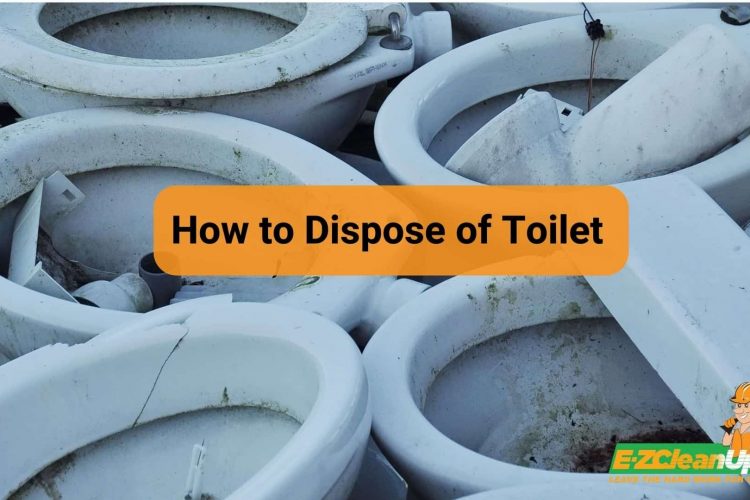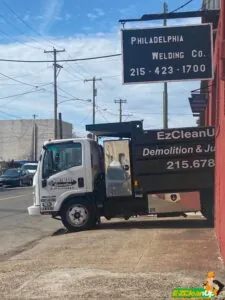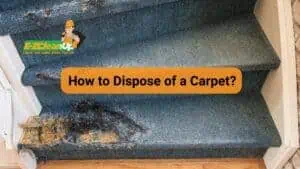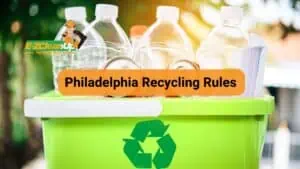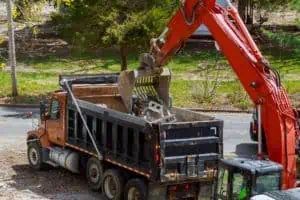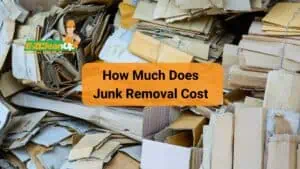Disposing of toilets properly prevents pollution, conserves resources, and ensures we’re doing our part for the environment. Toilets, especially older models, are often made of non-biodegradable materials like porcelain, which can last for centuries in landfills.
Here’s a peek at the steps you need to take:
- Disconnect the toilet from the plumbing.
- Prepare it for disposal by draining and cleaning.
- Choose an appropriate disposal method, like recycling or trash disposal.
- Transport it or have a junk removal service take it.
- Dispose it of.
Read on to learn more about how to dispose of a toilet responsibly, step-by-step!

Step #1: Disconnecting the Toilet
Follow these steps to disconnect the toilet for disposal:
Turn Off the Water Supply
This prevents any potential mess or water damage. Locate the water supply valve behind the toilet and turn it clockwise until it’s fully closed.
Remove the Tank Lid and Empty the Tank
Remove the tank lid and set it aside in a safe place. Flush the toilet to drain water from the tank. If any water remains, use a sponge or a small cup to remove it.
Disconnect the Water Supply Line
Use an adjustable wrench for this. Be prepared for a small amount of water to spill out when you disconnect the line, so have a towel ready.
Loosen Up and Remove the Toilet Bolts
Locate the bolts connecting the toilet to the floor — these are usually at the base of the toilet. Use a wrench to loosen and remove these bolts. If the bolts are rusted or stuck, apply a penetrating oil can to make them loose.
Lift and Transport the Toilet
Toilets can be heavy, so it’s advisable to have assistance. Lift the toilet straight up, being careful not to tilt it and spill any remaining water. Carry the toilet outside for further preparation or disposal. Always lift with your legs, not your back, to avoid injury.
Step #2: Prepare the Toilet for Disposal
Make sure that the toilet bowl is completely drained to avoid any spillage of water or waste materials during transportation.
Drain
Start by using a plunger to push as much water as possible through the trap, the S-shaped part of the toilet that holds standing water. Once you’ve removed as much water as you can with a plunger, use a sponge, towel, or a small cup to scoop out the remaining water. Absorb or scoop up the water and wring it out into a bucket.
Clean and Disinfect the Toilet
Start by applying a toilet bowl cleaner or a disinfectant around the rim and the sides of the bowl. It’s advisable to use a cleaner that effectively breaks down limescale and stains, as these can still be present even after the toilet has been disconnected. Allow the cleaner to sit for a few minutes according to the product’s instructions to soften any build-up and kill germs.
Then, using a toilet brush or a scrubbing brush, scrub the inside of the bowl thoroughly. Make sure to get under the rim and into all the crevices. Once scrubbed, flush the toilet if still connected to water, or rinse with a jug of water to wash away the residue of the cleaner and remove grime.
After scrubbing the inside, wipe down the exterior of the toilet with a disinfectant cleaner. Using a disposable cloth or paper towel is a good option for this step.
Remove Any Non-Recyclable Components
These components typically include the toilet seat, any plastic parts such as flush handles or internal mechanisms, and metal parts like bolts, screws, or hinges. Unscrewing the toilet seat from the bowl. Most seats are attached with two bolts at the back, which can usually be unscrewed with a standard screwdriver or an adjustable wrench.
Next, remove the flush handle, usually secured to the tank with a nut on the inside. Remember that the threading on these nuts can be reverse-threaded, which means you might need to turn it in the opposite direction than usual to loosen it.
Examine the inside of the tank and remove any plastic or metal parts, such as the flush mechanism, float, and chain. These parts can often be taken out by hand or with basic tools like a wrench or pliers.
Dismantle the Toilet, If Necessary
In some cases, you might need to dismantle the toilet into smaller pieces, especially if you plan to transport it to a recycling center or if it’s too large to fit in your disposal area.
To dismantle a toilet, start by removing the tank. Once the tank is off, you’ll be left with the bowl. The bowl can be heavy, so if you need to move it to a different location for disposal, make sure you have help. If further dismantling is needed, like removing the flushing mechanism from the tank, do so carefully, following the manufacturer’s instructions.
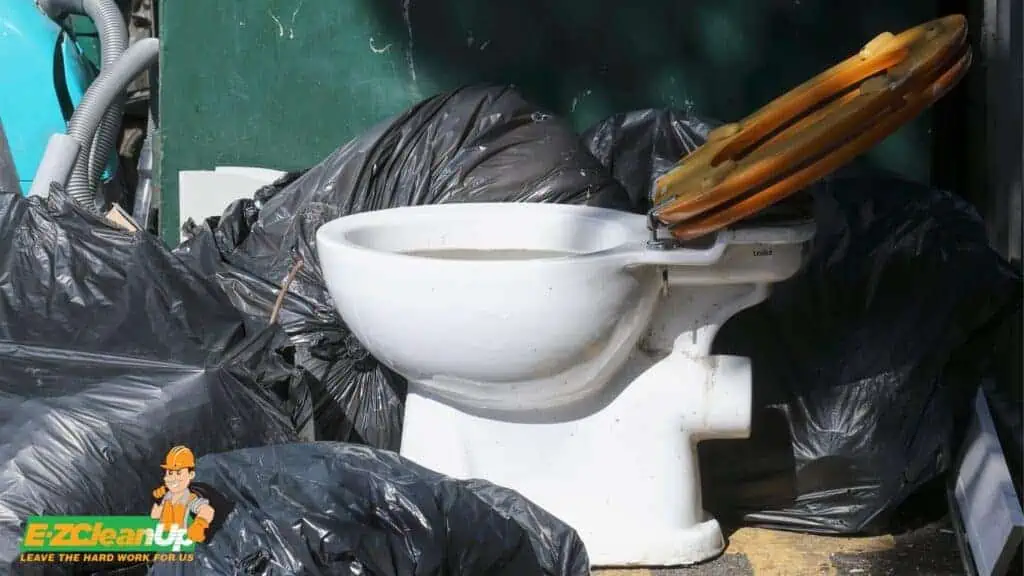
Step #3: Choosing the Right Disposal Method
Here are your options when thinking about how to dispose of a toilet:
Recycling
Recycling is a preferred method as it helps reduce landfill waste and supports the conservation of resources. The primary component of most toilets is porcelain, a recyclable material.
Porcelain can be crushed and repurposed for various uses, such as in aggregate for road construction, landscaping material, or even in the making of new porcelain products. However, not all recycling centers accept porcelain, so it’s important to research beforehand.
Start by contacting your local waste management authorities or doing an online search for recycling centers that accept porcelain near you. Once you locate a facility, inquire about their specific procedures for toilet porcelain. Some centers may require you to bring the toilet whole, while others might ask for it to be broken into smaller pieces.
In some cases, recycling centers might request that the tank and bowl of the toilet be recycled separately. This requirement is often due to the different sizes and shapes of these parts, which can affect how they’re processed.
If your local recycling facility doesn’t accept porcelain, or if transporting the toilet is impractical, consider other recycling options. Sometimes, construction and junk removal companies, like EZ CleanUp, accept porcelain toilets.
Trash Disposal with Local Guidelines
If recycling is not an option, disposing of your toilet through regular trash services may be necessary. However, it’s crucial to follow local guidelines to ensure this is done legally and responsibly. Most localities have specific regulations regarding the disposal of large fixtures like toilets.
Start by contacting your local waste management or sanitation department for guidance. They can provide information on whether you can leave the toilet out for regular trash pickup or if you need to bring it to a specific facility.
Repurposing or Upcycling Ideas for Old Toilets
Repurposing or upcycling your old toilet is a creative and eco-friendly way to extend its life beyond its original purpose. One popular idea is to use the toilet bowl as a creative planter. The bowl and tank can hold soil and plants. You can paint the exterior to suit your garden’s aesthetic or leave it as is for a more rustic look. Some even use the tank lid as a base for a birdbath or a makeshift bird feeder.
Another creative upcycling idea is to transform the toilet into an artistic statement piece. Mosaic artists, for instance, might use porcelain pieces as material for their art projects. Remember, upcycling projects should be practical, safe, and aligned with your personal or community aesthetic standards.
Donating to Charitable Organizations, If Possible
If your toilet is still in good working condition, consider donating it to a charitable organization. Before donating, ensure that the toilet is clean and functional and includes all necessary components for installation. Contact local charities, Habitat for Humanity ReStores, or similar organizations to inquire about their donation policies and whether they can accept a toilet.
Step #4: Transporting the Toilet
Once you have decided how to dispose of or repurpose your toilet, the next step is to transport it safely. Properly securing the toilet for transport is crucial to avoid any damage to the toilet (if you’re donating or upcycling it) and to ensure it doesn’t cause injury or vehicle damage.
Ensure Safety During Transportation
If the toilet is particularly heavy or awkward to handle, don’t attempt to lift it by yourself. In addition, when driving, choose a route with smooth roads to minimize jostling and potential damage. Drive carefully, and avoid sharp turns or sudden stops that could cause the toilet to shift or even break free of its restraints.
Check Local Regulations for Transportation
Different regions may have specific rules about transporting large items like toilets, especially if you’re bringing them to a recycling center or landfill. It’s wise to check these regulations beforehand.
Additionally, if you’re planning to dispose of the toilet at a landfill or dump, check their operating hours and any fees associated with disposal. Some facilities might also have specific requirements for how the toilet should be prepared for disposal, such as needing it to be broken into smaller pieces.
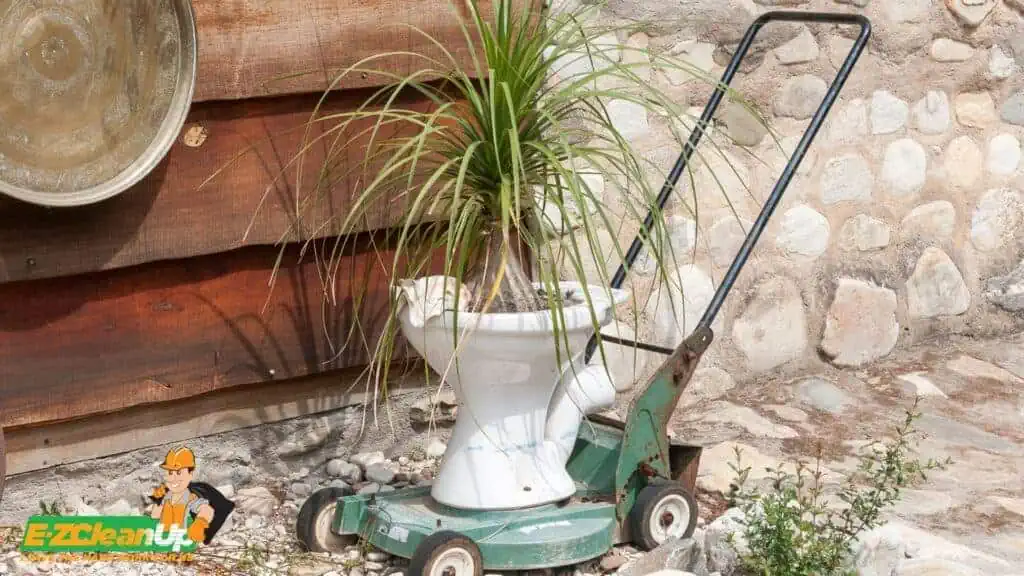
Step #5: Final Disposal
The actual disposal of your toilet, whether through recycling or trash, needs to be conducted in accordance with local guidelines and regulations.
For Recycling
If you’ve chosen to recycle your toilet, ensure that you’re following the specific procedures of the recycling center. This might include how the toilet should be broken down, whether the porcelain needs to be cleaned of any fixtures, or if the tank and bowl should be separated. Some recycling centers may also have specific instructions for handling any remaining water or chemical residue in the toilet.
For Trash Disposal
Many areas will not accept toilets as part of regular trash pickup and may require you to transport the toilet to a designated landfill or waste facility. There, you might need to follow specific procedures for bulky waste items.
Notify Local Waste Management Authorities If Required
In some regions, disposing of large household items like toilets requires prior notification or even permission from local waste management authorities. Failure to notify the authorities can sometimes lead to fines or the refusal of waste facilities to accept your toilet.
Document Disposal for Future Reference
Lastly, it’s wise to keep a record of your disposal process. This documentation should include where and how you disposed of or recycled the toilet, any costs involved, and the date of disposal. If you’ve donated the toilet, keep a record of the donation receipt or any other acknowledgment from the charity or organization.
Eco-Friendly Toilet Replacement
After responsibly disposing of your old toilet, you may be considering an eco-friendlier option for your bathroom. Replacing it with a more water-efficient model is not just good for the environment but can also reduce your water bills.
When looking for a new toilet, the main feature to look for is water efficiency. Water-efficient toilets are designed to use less water per flush.
There are several types of water-efficient toilets:
- Dual Flush Toilets: These toilets have two flush options – a low-volume flush for liquid waste and a standard flush for solid waste. This system allows you to choose the amount of water used per flush.
- Low-Flow Toilets: A more traditional option, these toilets use less water than older models. The standard used to be around 3.5 to 5 gallons per flush, but low-flow models use 1.6 gallons or less.
- High-Efficiency Toilets (HETs): These are an advanced type of low-flow toilets that use even less water than the federal standard – typically around 1.28 gallons per flush or less. HETs are often equipped with additional innovations like pressure-assist flush mechanisms to maximize efficiency.
- Composting Toilets: They require little or no water and convert waste into compost that can be used for gardening, although they may require more maintenance and are more suitable for certain locations.
Choosing the Right Model
- Efficiency Ratings: Look for high-efficiency toilets (HETs) with EPA’s WaterSense label to ensure they meet strict criteria for water usage and performance. These models use no more than 1.28 gallons per flush, significantly lower than older models that can use up to 6 gallons.
- Material and Durability: A durable model can last longer and reduce the need for future replacements.
- Sustainable Manufacturing: Research the manufacturer’s sustainability practices. Some companies commit to eco-friendly manufacturing processes and materials, which adds an extra layer of environmental responsibility to your purchase.
Proper Installation Techniques
- Sealing and Fitting: Ensure that the toilet is properly sealed and fitted. Use quality sealing materials and double-check connections.
- Tool Efficiency: Use tools and installation methods that minimize energy consumption. For example, manual tools can be used instead of electric ones where feasible.
Water Line Check
- Inspection for Leaks: Before installation, inspect existing water lines for leaks. Fixing leaks not only prevents water wastage but also ensures optimal performance of your new toilet.
- Upgrade Supply Lines: Consider upgrading supply lines and shut-off valves if they are old or worn out. Newer, high-quality components can be more reliable and durable.
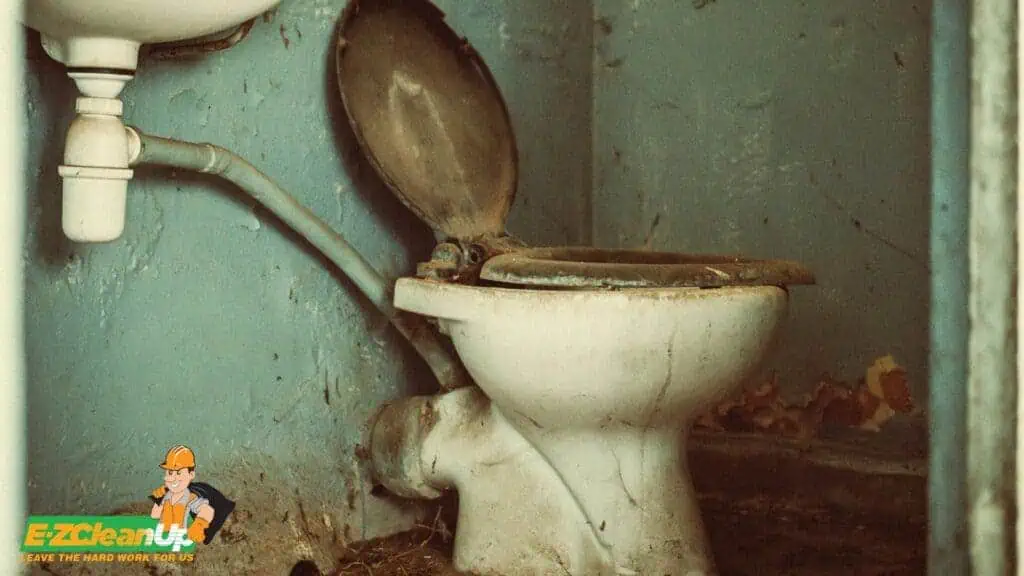
FAQs – How to Dispose of a Toilet
Should I Keep My Old Toilet?
It’s generally not advisable to keep an old toilet that’s no longer in use. Not only does it take up space, but older toilets are also less efficient in water usage compared to newer models. However, if your toilet is a unique or vintage style, you might consider repurposing it, for example, as a planter in your garden.
What Is the Lifespan of a Toilet?
Toilets can last a long time, often up to 50 years or more. However, the components inside the toilet, like the flushing mechanism, may need to be replaced or repaired more frequently. The decision to replace a toilet is often based more on its efficiency and appearance than on its outright failure.
Can I Reuse an Old Toilet?
Reusing an old toilet in a different location in your home or another property is feasible if it’s still in good working condition. Ensure all the necessary connections and fittings are compatible and in good shape. Alternatively, consider upcycling parts of the toilet for creative uses like outdoor planters or even unique furniture pieces.
What Are the Signs of a Toilet Going Bad?
Signs that your toilet may need to be replaced include frequent clogging, cracks in the porcelain, persistent leaks, a wobbly base, and excessive water usage.
Ready to Say Goodbye to Your Old Toilet? Do It the Right Way!
Disposing of an old toilet is a task that requires attention to detail. From disconnecting and preparing the toilet for disposal to choosing the right disposal method and ensuring safe transport and final disposal, every step is crucial for a responsible clean-up. Remember, replacing your old toilet also presents an opportunity to contribute positively to the environment by choosing eco-friendly, water-efficient models.
If you’re in Philadelphia, PA, or nearby and find the task of toilet disposal challenging, consider calling EZ CleanUp for professional assistance. We specialize in junk removal, including toilet disposal and even hot tub removal. With our expertise, we ensure that your toilet disposal is handled efficiently, safely, and in an eco-friendly manner.
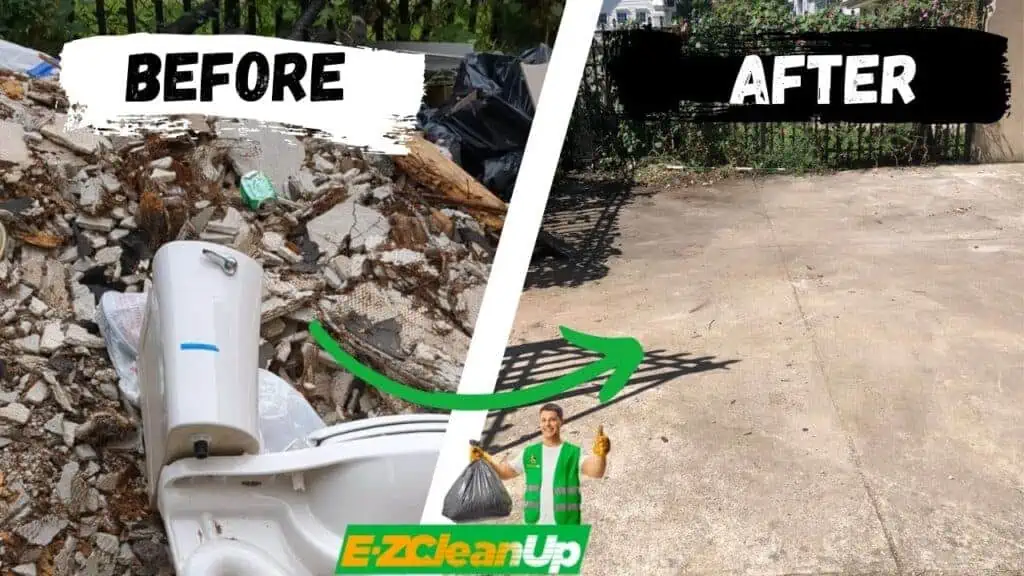
For a hassle-free, responsible, and environmentally friendly way to say goodbye to your old toilet and other junk, contact EZ CleanUp. Let’s work together to clear your space when you need it.

